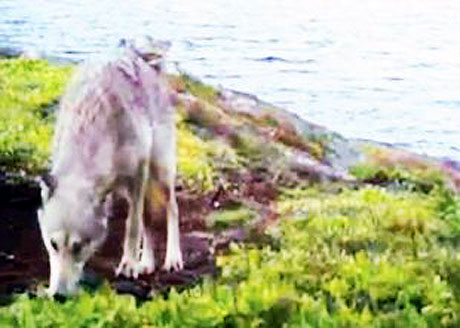Second Wolf Found in Newfoundland-Alive!!!
Parks Canada is reporting a second possible wolf-this one in Terra Nova National Park. The first wolf documented in Newfoundland in nearly a century was killed this year by a coyote hunter. As reported in The Telegram of Saint John’s, Newfoundland, the second animal was videotaped earlier this year. By all appearances the animal is a wolf. It’s long legs and very large feet are indicative of the Labrador gray wolf. (Click here to see article)
Wolves disappeared from Newfoundland in the early years of the 20th century as their primary prey, the caribou, were hunted nearly to extinction on the island. It is not known why wolves disappeared from Newfoundland, but the decrease in caribou numbers is believed to have played a major role. In the years since, caribou numbers have risen dramatically and the introduced moose population has exploded. The availability of natural prey is no longer an issue.
In the 1980’s, coywolves made their way onto Newfoundland traveling on ice floes. The range of the gray wolf in Labrador and Quebec extends to within ten miles of Newfoundland’s Northern Peninsula, just across from the Strait of Belle Isle. Each winter and spring, pack ice pushed down by the Labrador current fills the Strait, making shipping impossible and allowing wolves and polar bears to reach Newfoundland’s shores. In early 2012, four polar bears that reached Newfoundland were shot and killed. Coastal southern Labrador and eastern Quebec is barren land. Trees are sparse and there is little for wolves to eat. It is not hard to imagine that one or more wolves would want to attempt to cross the ice for more fertile territory. Upon reaching Newfoundland, wolves would find in excess of 100,000 moose and caribou combined, far more than the sparse caribou and moose populations that exist in eastern Quebec and southeast Labrador.
It remains to be seen how the province of Newfoundland and Labrador will respond to this wolf and the possibility that the wolf has returned. Newfoundland’s burgeoning moose population has become a serious hazard to motorists and hunting seasons have been expanded. The return of the wolf will undoubtedly help to keep the moose population in check. Newfoundland’s caribou population is declining, believed to be largely due to calf predation by black bears and habitat disruption. The return of the wolf may help to reduce the number of coywolves that also prey on caribou calves. In any event, the Newfoundland and Labrador government can ill-afford to ignore the situation. Many people in Newfoundland would welcome the wolf back and there is abundant habitat and prey for wolves. Rather than bury their heads in the sand, government officials need to wake up and smell the coffee, or in this case, the wolf scat.
Breaking News:
A canid killed by a trapper in Newfoundland in 2009 has now been determined to have been a gray wolf. It had earlier been misidentified because reference samples of DNA had not included wolves from Labrador. Read the story here.
